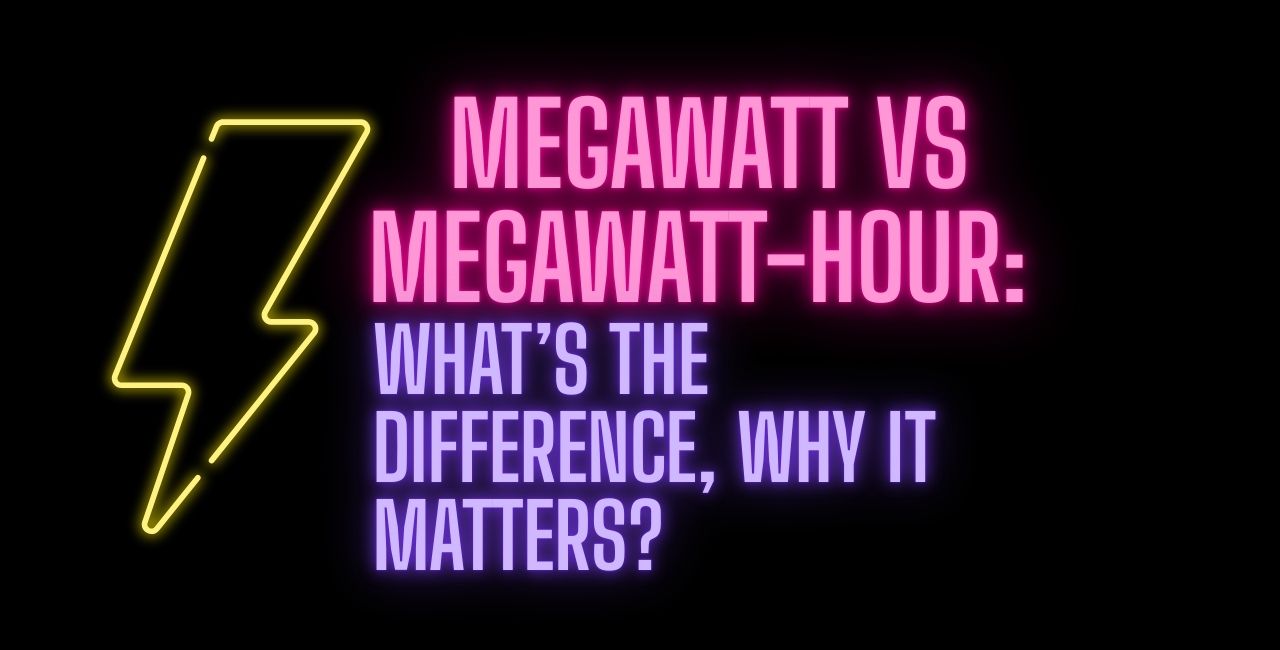
If you get confused after seeing megawatt (MW) and megawatt-hour (MWh), this blog is for you.
A megawatt (MW) is a unit of power, it’s the rate at which energy is generated or consumed. So, 1 MW equals 1,000,000 watts.
Think of your car’s speedometer — it shows your speed right now and not how far you’ve gone. The same way megawatts tells you how much power is being produced and used at instant.
You’ll see MW used to describe the capacity of power plants or solar farms. Here is one example for you, if a 1 MW solar array is producing 1 MW of power under perfect sunlight and is running continuously at full power for 24 hours, it will deliver 24 megawatt-hours (MWh).
In short, MW is about potential output or instantaneous power.
A megawatt-hour (MWh) is a measure of energy.
Think of it like water flowing from tap—the speed of the flow is MW, but the amount of water you get in that bucket after an hour is MWh.
Making it more simple for you:
To make it simple: MW tells you “how big,” while MWh tells you “how much over time.”
This is the formula:
Energy (MWh) = Power (MW) × Time (hours)
We have an example:
But the thing is: real-world systems don’t really operate at full capacity all the time. Solar panels don’t really generate power at night and the output is affected by clouds and shade if you talk about the day. This is where you need the capacity factor—it’s the percentage of time a system produces near its maximum output.
In the U.S., a regular solar farm might have a capacity factor of like 20–25%. So a 1 MW solar system won’t deliver 8,760 MWh per year (which would be the math if it ran at 100%); it’ll likely produce closer to 1,700–2,200 MWh annually also depending on location and design.
One of the most common mistakes people make is mixing up MW and MWh. Even news outlets get this wrong.
Best practice would be to stick with MW for capacity and MWh for energy. That way, you’ll avoid confusion.

Understanding megawatts (MW) and megawatt-hours (MWh) in everyday terms would help a lot so let’s break them down with real-world examples.
To build a solar system with a capacity of 1 MWp (megawatt peak), you’d need around 2,200 panels and each panel should be about 440 watts in size. That’s roughly the size of a utility-scale solar project rather than a typical rooftop installation.
What 1 MWh Can Power
Regional Differences
These numbers are average, but they can be different depending on the location and technology. Like homes in the U.S. use more electricity than Europe or India. So while 1 MWh might cover a month of power for a U.S. household, it could also stretch even further in regions where average household power usage is lower.
Thinking about energy this way makes the scale of MW and MWh more relatable—and shows just how much impact solar systems can have when scaled up.
If you’re in the solar industry—or even considering solar for your business—understanding MW vs MWh is critical.
For solar proposals, both numbers need to be presented:
Developers also model different scenarios—like P50 and P90 yield projections—to show the most likely vs conservative energy production. These numbers drive financial models, Power Purchase Agreements (PPAs), and project bankability.
MW tells you the size of the system, MWh tells you the value. Always include both in proposals to avoid confusion and build trust with buyers.
.png)
Here are some handy tools:
A simple cheat sheet is also helpful:
In solar, MW and MWh are two sides of the same coin — capacity versus output. A project’s MWp (megawatt-peak) refers to its installed DC capacity, often calculated by multiplying the number of solar panels by their rated wattage. But what owners and financiers truly care about is how much electricity the system will generate over time — expressed in MWh (megawatt-hours) per year.
That bridge between MW and MWh is defined by the capacity factor, local solar irradiance, system design, and performance losses. RatedPower notes that energy yield modeling often relies on P50 and P90 production estimates, which account for uncertainty in weather and system behavior.
Similarly, NREL and the IEA emphasize that these yield concepts are critical for bankability in PV projects.
For installers and developers, both metrics play distinct roles:
When you’re preparing proposals, it’s best practice to present both MWp and expected MWh/year, and clearly state the assumed capacity factor and losses (such as shading and inverter efficiency). This avoids confusion for buyers who may mistake MW for production, and it allows greater transparency.

What is the difference between MW and MWh?
A megawatt (MW) measures power capacity, while a megawatt-hour (MWh) measures energy produced or consumed over one hour.
Is MW a measure of energy or power?
MW is a measure of power, representing the rate of energy generation or consumption.
What does MWp mean?
MWp refers to “megawatt-peak,” the maximum DC capacity of a solar PV system under standard test conditions (Medium).
Can you compare MW to kW and MWh to kWh?
Yes. 1 MW equals 1,000 kW, and 1 MWh equals 1,000 kWh.
How many kWh are in 1 MWh?
1 MWh equals 1,000 kilowatt-hours.
How do you calculate energy from power?
Energy (E) is calculated by multiplying power (P) by time (t), expressed as E = P × t

To wrap things up:
For solar professionals, getting these numbers right can make or break a proposal. That’s where solar design software comes in. Platforms like ARKA 360 help you design projects, automatically calculate expected MWh from installed MWp, and generate proposals that clearly communicate value to clients.













